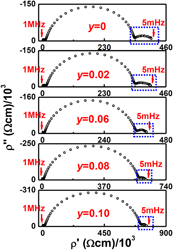Crossref Citations
This article has been cited by the following publications. This list is generated based on data provided by
Crossref.
Cai, Wei
Fu, Chun Lin
Chen, Gang
Deng, Xiao Ling
and
Liu, Kai Hua
2014.
Effects of Microwave Sintering Time on Microstructure, Dielectric, Ferroelectric Properties of Barium Zirconate Titanate Ceramics.
Key Engineering Materials,
Vol. 602-603,
Issue. ,
p.
786.
Wang, Min-Jia
Yang, Hui
Zhang, Qi-Long
Lin, Zhi-Sheng
Zhang, Zi-Shan
Yu, Dan
and
Hu, Liang
2014.
Microstructure and dielectric properties of BaTiO 3 ceramic doped with yttrium, magnesium, gallium and silicon for AC capacitor application.
Materials Research Bulletin,
Vol. 60,
Issue. ,
p.
485.
Guo, Yajing
and
Zhang, Yonggang
2017.
Effects of ZnO-H3BO3 addition on sintering behavior and dielectric properties of ZnO-MgO-TiO2-CaO ceramics.
Journal of Materials Science: Materials in Electronics,
Vol. 28,
Issue. 10,
p.
7248.
Carter, J. J.
Bayer, T. J. M.
and
Randall, C. A.
2017.
Degradation and recovery of iron doped barium titanate single crystals via modulus spectroscopy and thermally stimulated depolarization current.
Journal of Applied Physics,
Vol. 121,
Issue. 14,
Hong, Kootak
Lee, Tae Hyung
Suh, Jun Min
Yoon, Seok-Hyun
and
Jang, Ho Won
2019.
Perspectives and challenges in multilayer ceramic capacitors for next generation electronics.
Journal of Materials Chemistry C,
Vol. 7,
Issue. 32,
p.
9782.
Luo, Zhiping
Hao, Hua
Chen, Chen
Zhang, Lin
Yao, Zhonghua
Cao, Minghe
Emmanuel, Marwa
and
Liu, Hanxing
2019.
Dielectric and anti-reduction properties of (1-x)BaTiO3-xBi(Zn0.5Y0.5)O2.75 ceramics for BME-MLCC application.
Journal of Alloys and Compounds,
Vol. 794,
Issue. ,
p.
358.
Jiang, Kunlun
Zhang, Lei
Li, Bo
Li, Peng
Yu, Shuhui
Sun, Rong
Fu, Zhenxiao
and
Cao, Xiuhua
2022.
Importance of uniformity of grain size to reduce dc degradation and improve reliability of ultra-thin BaTiO3-based MLCCs.
Ceramics International,
Vol. 48,
Issue. 20,
p.
30020.
Luan, Saiwei
Li, Kun
Zhang, Lei
Yu, Shuhui
Sun, Rong
Fu, Zhenxiao
Liu, Jianmei
and
Zhang, Jiwei
2022.
The dependence of reliability on raw material in BME-MLCCs.
p.
1.
Tan, Junhui
Wang, Pengfei
Huang, Rongxia
Lin, Hua-Tay
Hu, Zhiping
Yang, Jun
Cheng, Lixia
Fu, Zhenxiao
Cao, Xiuhua
Zhang, Lei
Yu, Shuhui
and
Sun, Rong
2024.
Stability and reliability of BaTiO3-based MLCCs with high dielectric by rare-earth doping: an insight from domain-engineering.
Applied Physics A,
Vol. 130,
Issue. 8,
Chuong, Kayla Y.
Bock, Jon A.
Patterson, Eric A.
Brown-Shaklee, Harlan J.
Graber, Lukas
and
Garten, Lauren M.
2025.
Increasing Multilayer Ceramic Capacitor Lifetime With Bipolar Voltage Cycling.
IEEE Transactions on Components, Packaging and Manufacturing Technology,
Vol. 15,
Issue. 2,
p.
272.
Hsu, Hsuan-Jung
Yang, Kai Hsun
and
Hsiang, Hsing-I
2025.
Enhanced dielectric properties and thermal stability of BaTiO₃ ceramics sintered in a reducing atmosphere through MnNb₂O₆ doping.
Ceramics International,
Jang, Kyuseon
Kim, Mi-Yang
Jung, Chanwon
Kim, Se-Ho
Choi, Daechul
Park, Seong-Chan
Scheu, Christina
and
Choi, Pyuck-Pa
2025.
Direct Observation of Trace Elements in Barium Titanate of Multilayer Ceramic Capacitors Using Atom Probe Tomography.
Microscopy and Microanalysis,
Vol. 30,
Issue. 6,
p.
1047.
Hsu, Hsuan-Jung
Yang, Kai Hsun
and
Hsiang, Hsing-I
2025.
Effects of CaZrO3 doping on the oxygen vacancy formation and dielectric properties of BaTiO3 ceramics sintered in a reducing atmosphere.
Journal of Materials Science: Materials in Electronics,
Vol. 36,
Issue. 5,
Zhang, Weichen
Cheng, Xu
Zhen, Yichao
Cao, Xiuhua
Fu, Zhenxiao
Zhang, Hui
and
Wang, Xiaohui
2025.
Enhanced electrical reliability of Zr‐doped BaTiO3 nanoceramics: First‐principle calculations and experimental studies.
Journal of the American Ceramic Society,
Vol. 108,
Issue. 4,
Lee, Ga Young
Lee, Gil-Geun
Lim, Young Soo
and
Yoon, Seok-Hyun
2025.
Significantly enhanced reliability in highly accelerated life tests of Mg-doped BaTiO3 ceramics using a water-soluble Mg dopant.
Ceramics International,
Vol. 51,
Issue. 9,
p.
11627.



